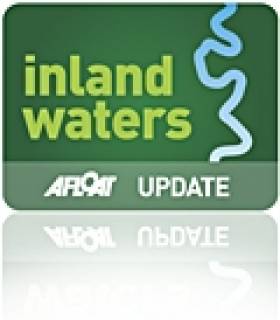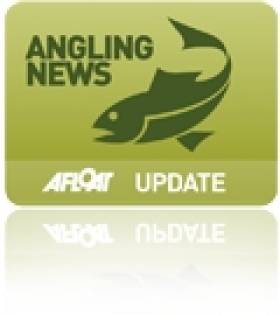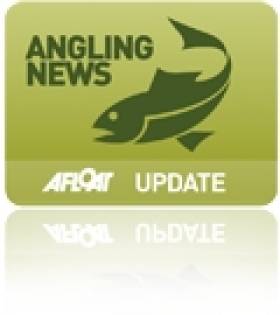Displaying items by tag: Longford
Inland Fisheries Ireland (IFI) has appealed to landowners to consult with it before carrying out works on or near watercourses after a Longford man was fined or disturbance of spawning beds.
Colm Ginty from Dunbeggan, Aughnacliffe, Co Longford was convicted and fined €1,000 and ordered to pay a further €1,727.91 towards costs and expenses at Longford District Court on 12 April following a prosecution taken by IFI.
Judge Bernie Owens convicted Ginty under Section 173(1)(d) Fisheries (Consolidation) Act 1959 for carrying out works on the Aughnacliffe River on 30 June 2021 that involved the removal of a substantial amount of gravel from the channel of the river and causing the destabilisation of the bank.
These works were carried out in an area of spawning habitat for wild brown trout and disturbed and injured sensitive spawning beds and bank where the spawn or fry of trout may be.
The court heard evidence from senior fisheries environmental officer Ailish Keane as to the adverse impacts caused by the actions, which occurred along a 90-metre section of the river.
Keane also outlined the negative long-term impacts that the works would have on the lifecycle of the brown trout for years to come.
She explained that IFI staff frequently consult with farmers who want to carry out works in rivers and outline the way works should be carried out to avoid potential damage to fish life.
The Aughnacliffe River is a tributary of the Erne River Catchment which contains a prime spawning habitat for wild brown trout.
Milton Matthews, director of the North West River Basin District at IFI said: “Unauthorised and unplanned instream works put undue pressure on our native fish stocks through loss or degradation of fisheries habitat and spawning areas.
“It is a landowner's responsibility to get in contact with their agricultural advisor or Inland Fisheries Ireland before carrying out any works in or along on watercourses. Failure to do so may result in unnecessary and damaging impact to fisheries habitat and may be liable to prosecution.”
Lakelands Holiday Park Set To Put Longford On Tourism Map
#InlandWaters - An articificial lake will be the centrepiece of a new holiday retreat near Lough Ree, as The Irish Times reports.
Center Parcs' Longford Forest is set to go before planners next month, but the adventure village chain has already revealed its proposals for the 150-hectare site in Newcastle Wood near Ballymahon, Co Longford.
These comprise 500 chalets, including a number of treehouses, and amenities such as shops and restaurants situated around an artifical lake an an indoor "subtropical swimming centre".
The proposed location, owned by Coillte, is currently home to some 50 fallow deer that would have to be relocated to adjacent woodland during construction for the park, scheduled to open in 2019.
Meanwhile, Center Parcs says the vast majority of local people back its €100 million plans for Newcastle Wood, expected to boost significantly boost tourism to that corner of the Lakelands region.
And as Ronan McGreevy writes in The Irish Times, "it is hard to find anyone in Longford who is not enthusiastic about the prospect of Center Parcs coming to the county." More on the story HERE.
Pig Farmer Prosecuted Over Lake Pollution 'Disgrace'
#InlandWaters - "An absolute disgrace" is how a judge branded a Longford farmer convicted of polluting a local lake near Lough Ree with slurry from his pig farm.
According to The Irish Times, Donal Connaughton of Newtowncashel was found to have caused or permitted effluent to fall from up to 25 slurry tanks containing a total of four million gallons from his property in March last year.
Longford District Court heard that many of the tanks were unauthorised structures and that Connaughton had removed their roofs to comply with a previous demolition order, only making the pollution problem worse by allowing overflow to enter local water courses.
Judge Séamus Hughes jailed Connaughton for 10 weeks and fined him €3,000 with €5,400 costs. The Irish Times has more on the story HERE.
Lanesborough Reopening Following Asian Clam Invasion
#asianclam – Inland Fisheries Ireland (IFI) has today confirmed that the hot-water stretch in Lanesborough, Co. Longford has re-opened to angling, under strict bio-security conditions.
Four disinfection units, funded by the ESB, have been installed by Inland Fisheries Ireland and are now operational. Two of the units are available above and below Lanesborough Bridge on the bankside, one unit is available at the Lanesborough boat slipway and the fourth unit is available on the Ballyleague angling bank.
IFI has advised that all anglers fishing on this angling stretch must disinfect all fishing equipment and waders on departure.
Signage has been erected at each disinfection unit, containing the appropriate disinfection solution, explaining how to disinfect properly. These units are secured outside normal fishing times but a contact number is available on the signage should an angler require it.
Due to the continued presence of the Asian Clam within this angling stretch, Inland Fisheries Ireland has prohibited the use of any keep net in this area for the foreseeable future.
Measures Outlined To Tackle Asian Clam In Longford Angling Waters
#Angling - Inland Fisheries Ireland says it is working closely with all relevant agencies as well as local community and angling groups to put "immediate measures" in place to re-open the Lanesborough fishery to angling after this month's Asian clam scare.
As previously reported on Afloat.ie, IFI prohibited angling at the 'hot water' stretch in Lanesborough, Co Longford after confirmation that the invasive species Corbilcula fluminea was present downstream of the ESB plant on Lough Ree.
In a statement issued late last week (18 September), IFI says disinfection stations, funded by the ESB, will be provided – and managed within the local community – over this week and next.
Combined with "a responsible attitude by all water users", it is hoped this "will facilitate the resumption of angling activity in the community".
The relevant agencies involved – the National Parks and Wildlife Service, Waterways Ireland, ESB, Bord Na Mona, the Office of Public Works and Roscommon and Longford County Councils – unanimously agreed that a detailed scientific survey would be carried out by this weekend.
"This will accumulate quantitative data and the extent of the distribution of this invasive species to augment the knowledge from the preliminary assessments," says IFI, which adds that the outcome "will inform decisions on the collaborative actions required for the medium and long term interventions and strategies".
In addition, the inland fisheries agency underlined that "continued awareness and responsible behaviour by all water users is paramount to ensuring the work of the agencies involved has the best chance for success and the prevention of any further spread.
"In that regard, all of the agencies appeal to the respective stakeholders to continue to observe bio-security measures, seek advice on any planned activity and assist in the efforts to manage a very difficult situation."































































